Using the Package Migration Wizard
You can invoke the Package Migration Wizard from multiple places. Depending on where you invoke the wizard from, the migrated package destination location will be different. For example, if you invoke the wizard from BIDS, it will assume that you want to migrate DTS 2000 packages into a SSIS package file (.dtsx). If the wizard is invoked from command line, it will assume that you want to migrate the package into the MSDB database on a server you define. Below are ways you can use to invoke the Package Migration Wizard:
-
From SQL Server Management Studio, you can invoke the Package Migrate Wizard by using the right-click context menu of the Legacy node under the Management node in the Object Explorer, as shown in Figure 12-2.
-
From BIDS, right-click SSIS Packages in Solution Explorer and pick Migrate DTS 2000 Package, as shown in Figure 12-3.
-
From a DOS prompt, type DTSMigrationWizard to invoke the wizard. By default, the binary DTSMigrationWizard.exe resides at C:\Program Files\Microsoft SQL Server\90\DTS\Binn folder. This may be different in your environment if you customized your SQL Server 2005 installation.

Figure 12-2
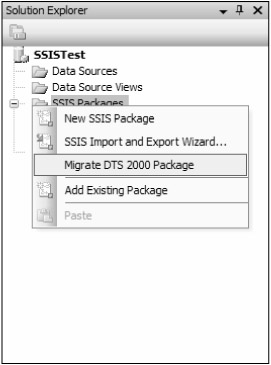
Figure 12-3
Since BIDS is the home where you create, manage, and edit your SSIS packages, you'll use BIDS to see step-by-step how you can migrate the package you created in the previous section.
-
Invoke the Package Migration Wizard. You will see a welcome window from the wizard. Click Next to continue.
-
In the next page, shown in Figure 12-4, you choose the source type and location. In this case, you can assume that your package is stored in the local default SQL Server 2000 server. Click Next.
-
The next page of the wizard asks you to pick the destination location of the package you are migrating, as shown in Figure 12-5. As mentioned earlier, since the wizard is invoked within BIDS, it assumes that you want the package in a .dtsx file format. You can see from the figure that the Destination drop-down list box is grayed out and the default selection is DTSX File. If you want to migrate the package to a database server, invoke the package from command line instead. In this case, you can pick F:\SSIS as the destination folder. Click Next.
-
In the next step, the wizard lists the packages available on the source server that can be migrated, as shown in Figure 12-6. In this case, there's only one package, GetServiceInfo, which you created earlier. Check the box next to the package name. Note that it even gives you the choice of migrating previous versions of the package. Click Next.
-
The wizard then asks you to provide a log file location, as shown in Figure 12-7. The log file will log the migration process. This information will be valuable if the migration is unsuccessful. You will use F:\SSIS\Migration.log file. Click Next.
-
You now will see a summary screen of this migration-related information, as shown in Figure 12-8. You can scan over and go back and change settings, if desired. Otherwise, click Finish to migrate the package now.
-
The migration process starts. You will see its progress in real time. After it is done, you can click the Report button to view the migration report. In this case, your GetServiceInfo package has migrated successfully, as shown in Figure 12-9. Click Close to finish the Package Migration Wizard. If for any reason the migration is not successful, the error will be in the final report. Based on the error message, you will be able to fix what is wrong to continue.
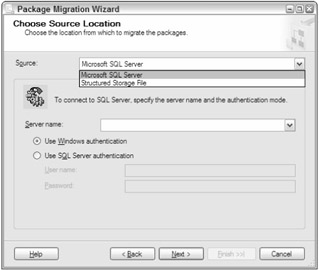
Figure 12-4
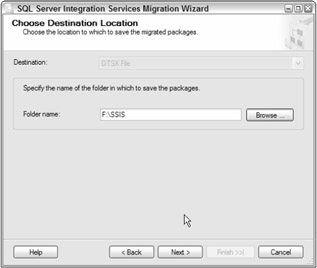
Figure 12-5
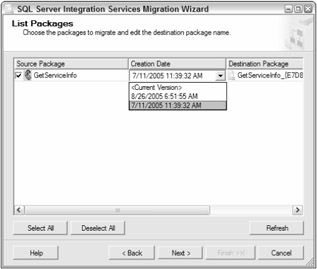
Figure 12-6
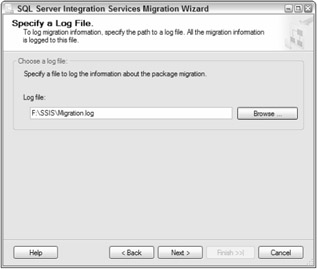
Figure 12-7
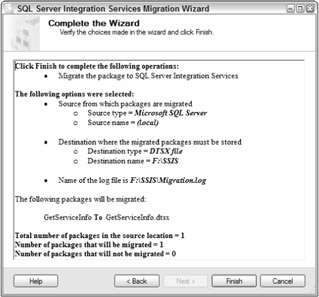
Figure 12-8
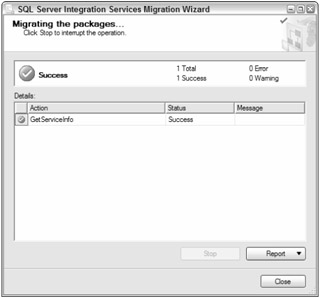
Figure 12-9
After the migration is complete, the GetServiceInfo.dtsx file will be opened within BIDS, as you can see in Figure 12-10.
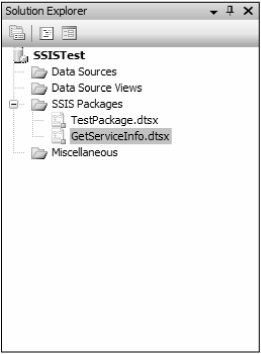
Figure 12-10
Press F5 to start package execution and it will be successful, as shown in Figure 12-11.
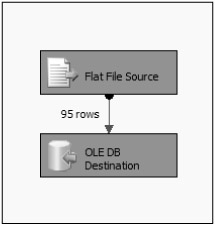
Figure 12-11
EAN: 2147483647
Pages: 182